Project 6002: Analyzing Project Sequencing, Costs and Schedules
VerifiedAdded on 2020/04/01
|7
|1578
|36
Project
AI Summary
This project analyzes project management concepts, focusing on sequencing activities, critical path analysis, and cost estimation within the context of the POM project. The document outlines the process of sequencing activities, including inputs, tools, and techniques like PDM, and the generation of network diagrams. It then delves into the critical path, emphasizing its importance in project scheduling and the consequences of delays. Furthermore, the project explores cost estimation, defining direct and indirect costs and detailing various estimation tools and techniques, such as expert judgment and parametric estimation. The document also provides examples of direct and indirect costs within the POM project, including labor, construction, and infrastructural costs, along with a list of references used.

Project 6002
Name
Date
Name
Date
Paraphrase This Document
Need a fresh take? Get an instant paraphrase of this document with our AI Paraphraser
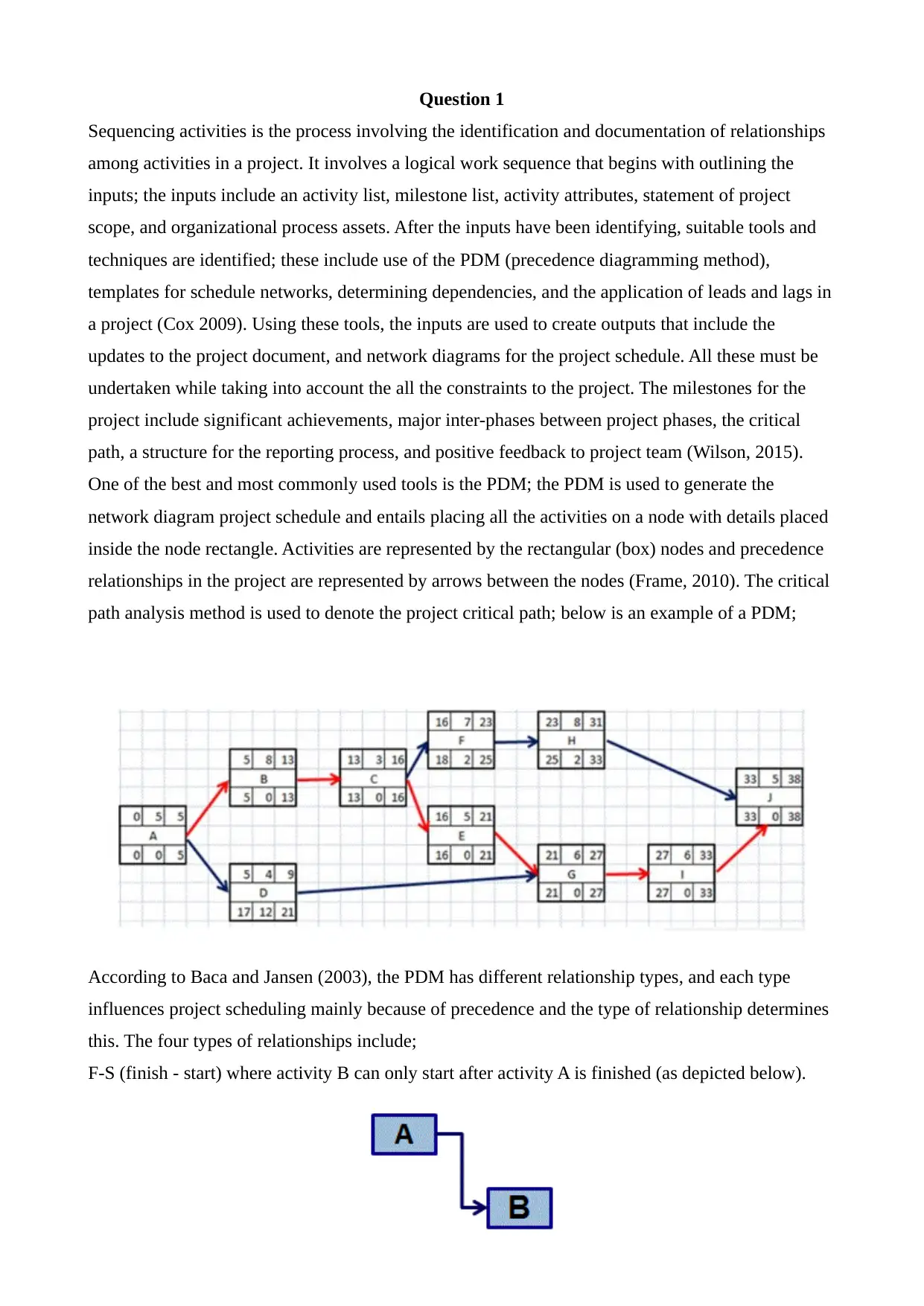
Question 1
Sequencing activities is the process involving the identification and documentation of relationships
among activities in a project. It involves a logical work sequence that begins with outlining the
inputs; the inputs include an activity list, milestone list, activity attributes, statement of project
scope, and organizational process assets. After the inputs have been identifying, suitable tools and
techniques are identified; these include use of the PDM (precedence diagramming method),
templates for schedule networks, determining dependencies, and the application of leads and lags in
a project (Cox 2009). Using these tools, the inputs are used to create outputs that include the
updates to the project document, and network diagrams for the project schedule. All these must be
undertaken while taking into account the all the constraints to the project. The milestones for the
project include significant achievements, major inter-phases between project phases, the critical
path, a structure for the reporting process, and positive feedback to project team (Wilson, 2015).
One of the best and most commonly used tools is the PDM; the PDM is used to generate the
network diagram project schedule and entails placing all the activities on a node with details placed
inside the node rectangle. Activities are represented by the rectangular (box) nodes and precedence
relationships in the project are represented by arrows between the nodes (Frame, 2010). The critical
path analysis method is used to denote the project critical path; below is an example of a PDM;
According to Baca and Jansen (2003), the PDM has different relationship types, and each type
influences project scheduling mainly because of precedence and the type of relationship determines
this. The four types of relationships include;
F-S (finish - start) where activity B can only start after activity A is finished (as depicted below).
Sequencing activities is the process involving the identification and documentation of relationships
among activities in a project. It involves a logical work sequence that begins with outlining the
inputs; the inputs include an activity list, milestone list, activity attributes, statement of project
scope, and organizational process assets. After the inputs have been identifying, suitable tools and
techniques are identified; these include use of the PDM (precedence diagramming method),
templates for schedule networks, determining dependencies, and the application of leads and lags in
a project (Cox 2009). Using these tools, the inputs are used to create outputs that include the
updates to the project document, and network diagrams for the project schedule. All these must be
undertaken while taking into account the all the constraints to the project. The milestones for the
project include significant achievements, major inter-phases between project phases, the critical
path, a structure for the reporting process, and positive feedback to project team (Wilson, 2015).
One of the best and most commonly used tools is the PDM; the PDM is used to generate the
network diagram project schedule and entails placing all the activities on a node with details placed
inside the node rectangle. Activities are represented by the rectangular (box) nodes and precedence
relationships in the project are represented by arrows between the nodes (Frame, 2010). The critical
path analysis method is used to denote the project critical path; below is an example of a PDM;
According to Baca and Jansen (2003), the PDM has different relationship types, and each type
influences project scheduling mainly because of precedence and the type of relationship determines
this. The four types of relationships include;
F-S (finish - start) where activity B can only start after activity A is finished (as depicted below).
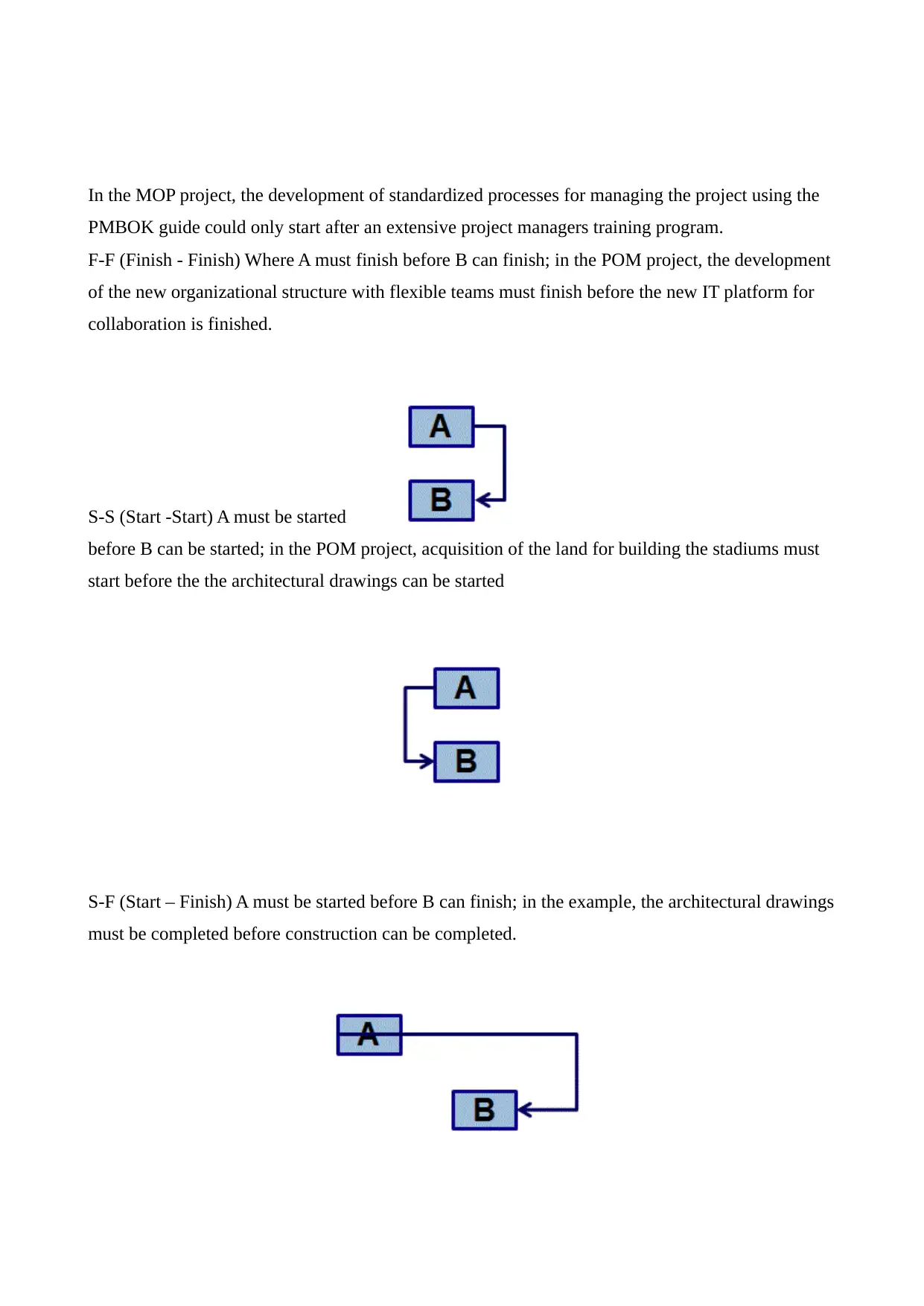
In the MOP project, the development of standardized processes for managing the project using the
PMBOK guide could only start after an extensive project managers training program.
F-F (Finish - Finish) Where A must finish before B can finish; in the POM project, the development
of the new organizational structure with flexible teams must finish before the new IT platform for
collaboration is finished.
S-S (Start -Start) A must be started
before B can be started; in the POM project, acquisition of the land for building the stadiums must
start before the the architectural drawings can be started
S-F (Start – Finish) A must be started before B can finish; in the example, the architectural drawings
must be completed before construction can be completed.
PMBOK guide could only start after an extensive project managers training program.
F-F (Finish - Finish) Where A must finish before B can finish; in the POM project, the development
of the new organizational structure with flexible teams must finish before the new IT platform for
collaboration is finished.
S-S (Start -Start) A must be started
before B can be started; in the POM project, acquisition of the land for building the stadiums must
start before the the architectural drawings can be started
S-F (Start – Finish) A must be started before B can finish; in the example, the architectural drawings
must be completed before construction can be completed.
⊘ This is a preview!⊘
Do you want full access?
Subscribe today to unlock all pages.

Trusted by 1+ million students worldwide
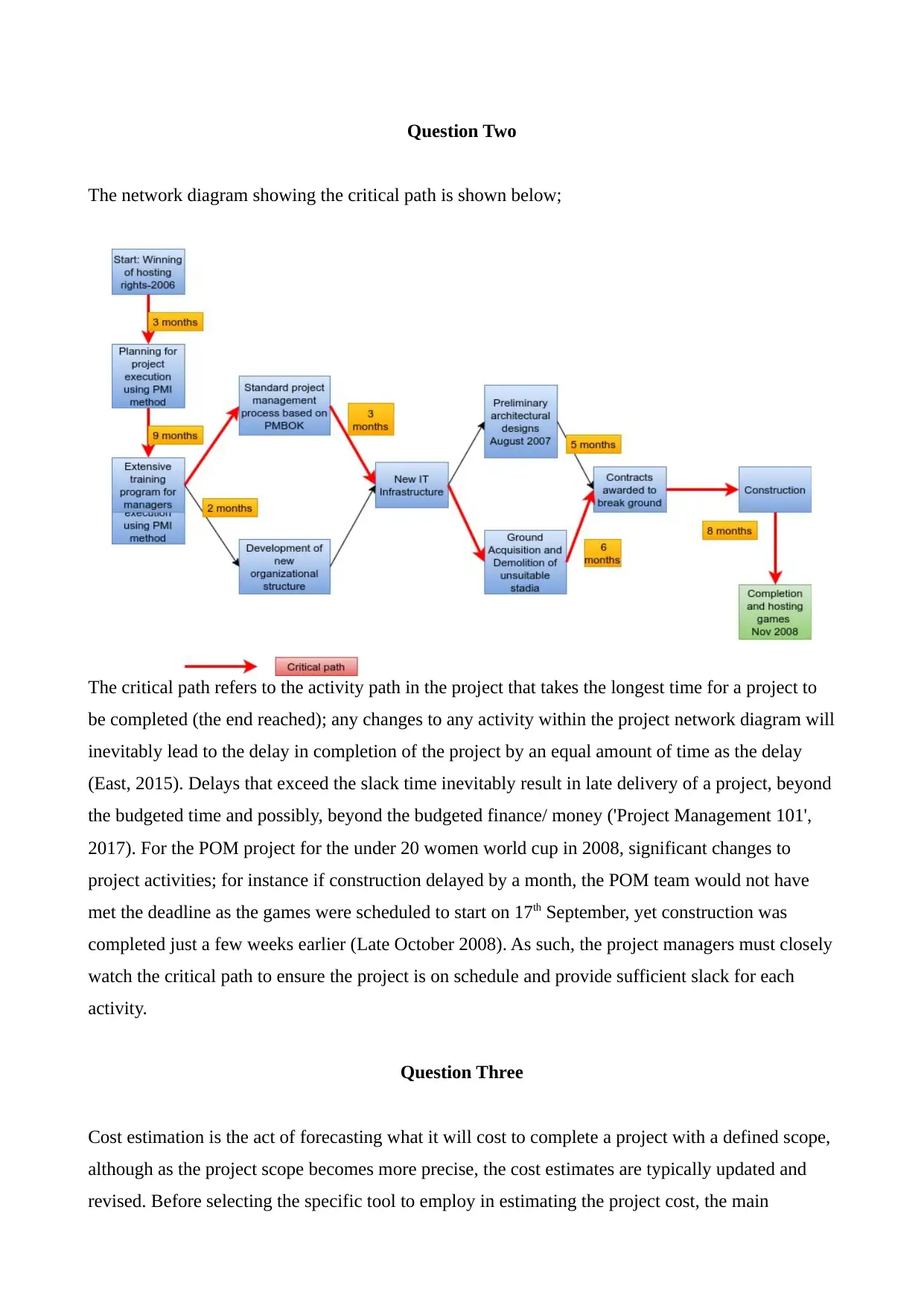
Question Two
The network diagram showing the critical path is shown below;
The critical path refers to the activity path in the project that takes the longest time for a project to
be completed (the end reached); any changes to any activity within the project network diagram will
inevitably lead to the delay in completion of the project by an equal amount of time as the delay
(East, 2015). Delays that exceed the slack time inevitably result in late delivery of a project, beyond
the budgeted time and possibly, beyond the budgeted finance/ money ('Project Management 101',
2017). For the POM project for the under 20 women world cup in 2008, significant changes to
project activities; for instance if construction delayed by a month, the POM team would not have
met the deadline as the games were scheduled to start on 17th September, yet construction was
completed just a few weeks earlier (Late October 2008). As such, the project managers must closely
watch the critical path to ensure the project is on schedule and provide sufficient slack for each
activity.
Question Three
Cost estimation is the act of forecasting what it will cost to complete a project with a defined scope,
although as the project scope becomes more precise, the cost estimates are typically updated and
revised. Before selecting the specific tool to employ in estimating the project cost, the main
The network diagram showing the critical path is shown below;
The critical path refers to the activity path in the project that takes the longest time for a project to
be completed (the end reached); any changes to any activity within the project network diagram will
inevitably lead to the delay in completion of the project by an equal amount of time as the delay
(East, 2015). Delays that exceed the slack time inevitably result in late delivery of a project, beyond
the budgeted time and possibly, beyond the budgeted finance/ money ('Project Management 101',
2017). For the POM project for the under 20 women world cup in 2008, significant changes to
project activities; for instance if construction delayed by a month, the POM team would not have
met the deadline as the games were scheduled to start on 17th September, yet construction was
completed just a few weeks earlier (Late October 2008). As such, the project managers must closely
watch the critical path to ensure the project is on schedule and provide sufficient slack for each
activity.
Question Three
Cost estimation is the act of forecasting what it will cost to complete a project with a defined scope,
although as the project scope becomes more precise, the cost estimates are typically updated and
revised. Before selecting the specific tool to employ in estimating the project cost, the main
Paraphrase This Document
Need a fresh take? Get an instant paraphrase of this document with our AI Paraphraser
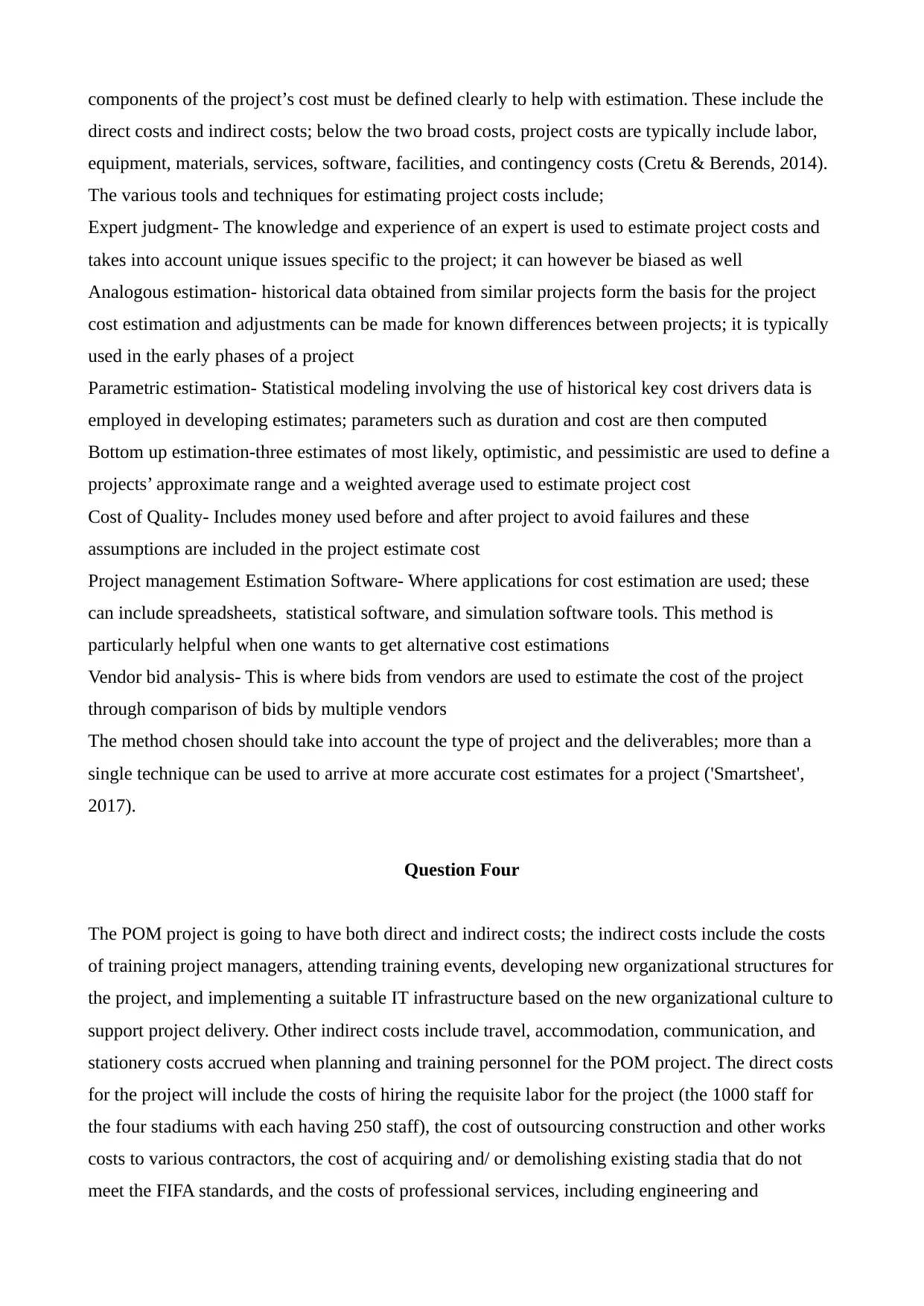
components of the project’s cost must be defined clearly to help with estimation. These include the
direct costs and indirect costs; below the two broad costs, project costs are typically include labor,
equipment, materials, services, software, facilities, and contingency costs (Cretu & Berends, 2014).
The various tools and techniques for estimating project costs include;
Expert judgment- The knowledge and experience of an expert is used to estimate project costs and
takes into account unique issues specific to the project; it can however be biased as well
Analogous estimation- historical data obtained from similar projects form the basis for the project
cost estimation and adjustments can be made for known differences between projects; it is typically
used in the early phases of a project
Parametric estimation- Statistical modeling involving the use of historical key cost drivers data is
employed in developing estimates; parameters such as duration and cost are then computed
Bottom up estimation-three estimates of most likely, optimistic, and pessimistic are used to define a
projects’ approximate range and a weighted average used to estimate project cost
Cost of Quality- Includes money used before and after project to avoid failures and these
assumptions are included in the project estimate cost
Project management Estimation Software- Where applications for cost estimation are used; these
can include spreadsheets, statistical software, and simulation software tools. This method is
particularly helpful when one wants to get alternative cost estimations
Vendor bid analysis- This is where bids from vendors are used to estimate the cost of the project
through comparison of bids by multiple vendors
The method chosen should take into account the type of project and the deliverables; more than a
single technique can be used to arrive at more accurate cost estimates for a project ('Smartsheet',
2017).
Question Four
The POM project is going to have both direct and indirect costs; the indirect costs include the costs
of training project managers, attending training events, developing new organizational structures for
the project, and implementing a suitable IT infrastructure based on the new organizational culture to
support project delivery. Other indirect costs include travel, accommodation, communication, and
stationery costs accrued when planning and training personnel for the POM project. The direct costs
for the project will include the costs of hiring the requisite labor for the project (the 1000 staff for
the four stadiums with each having 250 staff), the cost of outsourcing construction and other works
costs to various contractors, the cost of acquiring and/ or demolishing existing stadia that do not
meet the FIFA standards, and the costs of professional services, including engineering and
direct costs and indirect costs; below the two broad costs, project costs are typically include labor,
equipment, materials, services, software, facilities, and contingency costs (Cretu & Berends, 2014).
The various tools and techniques for estimating project costs include;
Expert judgment- The knowledge and experience of an expert is used to estimate project costs and
takes into account unique issues specific to the project; it can however be biased as well
Analogous estimation- historical data obtained from similar projects form the basis for the project
cost estimation and adjustments can be made for known differences between projects; it is typically
used in the early phases of a project
Parametric estimation- Statistical modeling involving the use of historical key cost drivers data is
employed in developing estimates; parameters such as duration and cost are then computed
Bottom up estimation-three estimates of most likely, optimistic, and pessimistic are used to define a
projects’ approximate range and a weighted average used to estimate project cost
Cost of Quality- Includes money used before and after project to avoid failures and these
assumptions are included in the project estimate cost
Project management Estimation Software- Where applications for cost estimation are used; these
can include spreadsheets, statistical software, and simulation software tools. This method is
particularly helpful when one wants to get alternative cost estimations
Vendor bid analysis- This is where bids from vendors are used to estimate the cost of the project
through comparison of bids by multiple vendors
The method chosen should take into account the type of project and the deliverables; more than a
single technique can be used to arrive at more accurate cost estimates for a project ('Smartsheet',
2017).
Question Four
The POM project is going to have both direct and indirect costs; the indirect costs include the costs
of training project managers, attending training events, developing new organizational structures for
the project, and implementing a suitable IT infrastructure based on the new organizational culture to
support project delivery. Other indirect costs include travel, accommodation, communication, and
stationery costs accrued when planning and training personnel for the POM project. The direct costs
for the project will include the costs of hiring the requisite labor for the project (the 1000 staff for
the four stadiums with each having 250 staff), the cost of outsourcing construction and other works
costs to various contractors, the cost of acquiring and/ or demolishing existing stadia that do not
meet the FIFA standards, and the costs of professional services, including engineering and

architectural. Other direct costs include the costs of equipment, the cost of software purchased to
help in managing the project, communications costs, and the facilities costs such as the costs of
renting the project management office and other project offices at the site of the projects. Another
cost that is direct to the project include the contingency costs; these are costs that are added to the
total budgeted project cost for tackling various risks and incidents. Other direct costs includes the
costs of insurance and financing costs used for funding the project, such as grants and loans.
help in managing the project, communications costs, and the facilities costs such as the costs of
renting the project management office and other project offices at the site of the projects. Another
cost that is direct to the project include the contingency costs; these are costs that are added to the
total budgeted project cost for tackling various risks and incidents. Other direct costs includes the
costs of insurance and financing costs used for funding the project, such as grants and loans.
⊘ This is a preview!⊘
Do you want full access?
Subscribe today to unlock all pages.

Trusted by 1+ million students worldwide
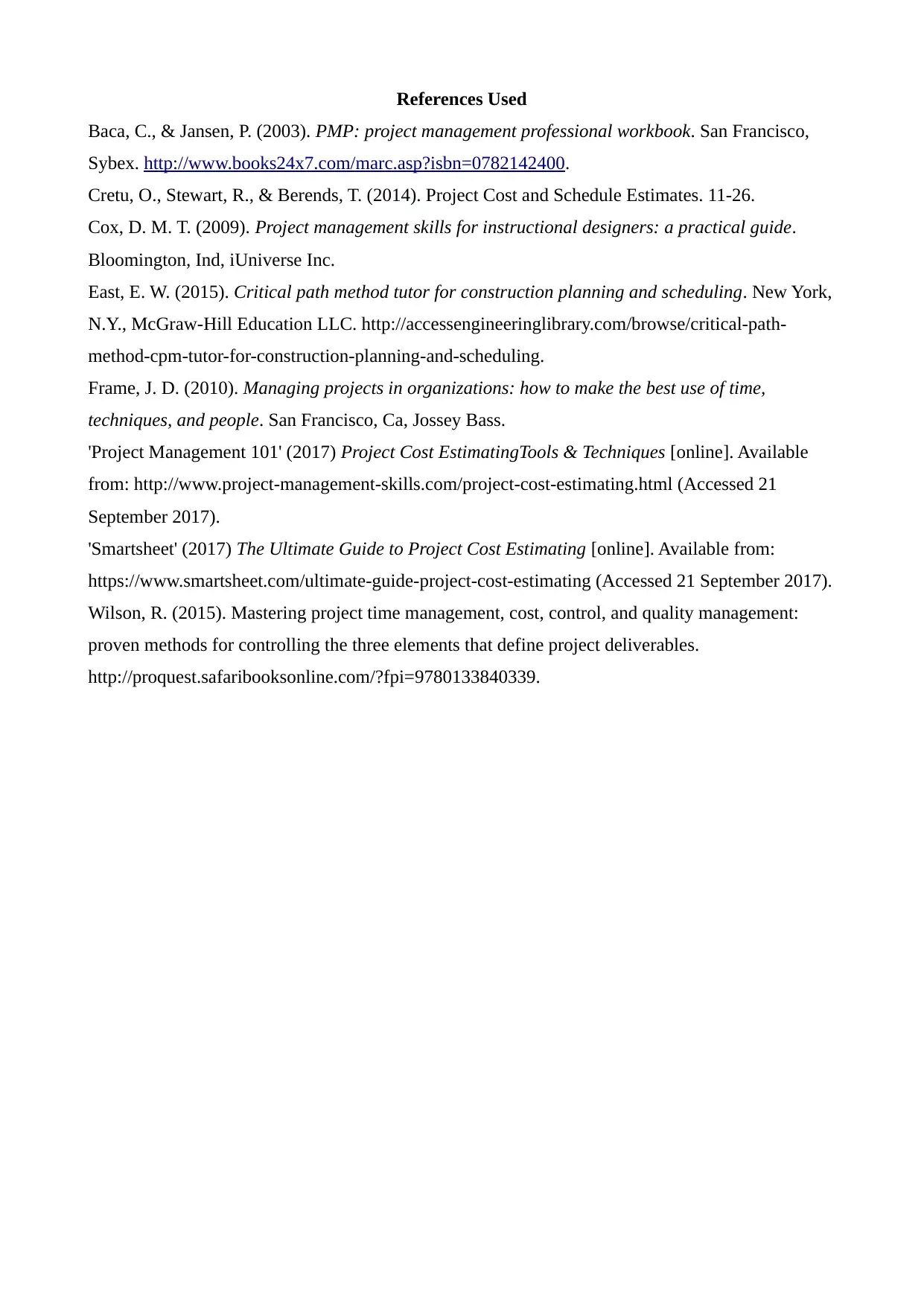
References Used
Baca, C., & Jansen, P. (2003). PMP: project management professional workbook. San Francisco,
Sybex. http://www.books24x7.com/marc.asp?isbn=0782142400.
Cretu, O., Stewart, R., & Berends, T. (2014). Project Cost and Schedule Estimates. 11-26.
Cox, D. M. T. (2009). Project management skills for instructional designers: a practical guide.
Bloomington, Ind, iUniverse Inc.
East, E. W. (2015). Critical path method tutor for construction planning and scheduling. New York,
N.Y., McGraw-Hill Education LLC. http://accessengineeringlibrary.com/browse/critical-path-
method-cpm-tutor-for-construction-planning-and-scheduling.
Frame, J. D. (2010). Managing projects in organizations: how to make the best use of time,
techniques, and people. San Francisco, Ca, Jossey Bass.
'Project Management 101' (2017) Project Cost EstimatingTools & Techniques [online]. Available
from: http://www.project-management-skills.com/project-cost-estimating.html (Accessed 21
September 2017).
'Smartsheet' (2017) The Ultimate Guide to Project Cost Estimating [online]. Available from:
https://www.smartsheet.com/ultimate-guide-project-cost-estimating (Accessed 21 September 2017).
Wilson, R. (2015). Mastering project time management, cost, control, and quality management:
proven methods for controlling the three elements that define project deliverables.
http://proquest.safaribooksonline.com/?fpi=9780133840339.
Baca, C., & Jansen, P. (2003). PMP: project management professional workbook. San Francisco,
Sybex. http://www.books24x7.com/marc.asp?isbn=0782142400.
Cretu, O., Stewart, R., & Berends, T. (2014). Project Cost and Schedule Estimates. 11-26.
Cox, D. M. T. (2009). Project management skills for instructional designers: a practical guide.
Bloomington, Ind, iUniverse Inc.
East, E. W. (2015). Critical path method tutor for construction planning and scheduling. New York,
N.Y., McGraw-Hill Education LLC. http://accessengineeringlibrary.com/browse/critical-path-
method-cpm-tutor-for-construction-planning-and-scheduling.
Frame, J. D. (2010). Managing projects in organizations: how to make the best use of time,
techniques, and people. San Francisco, Ca, Jossey Bass.
'Project Management 101' (2017) Project Cost EstimatingTools & Techniques [online]. Available
from: http://www.project-management-skills.com/project-cost-estimating.html (Accessed 21
September 2017).
'Smartsheet' (2017) The Ultimate Guide to Project Cost Estimating [online]. Available from:
https://www.smartsheet.com/ultimate-guide-project-cost-estimating (Accessed 21 September 2017).
Wilson, R. (2015). Mastering project time management, cost, control, and quality management:
proven methods for controlling the three elements that define project deliverables.
http://proquest.safaribooksonline.com/?fpi=9780133840339.
1 out of 7
Related Documents
Your All-in-One AI-Powered Toolkit for Academic Success.
+13062052269
info@desklib.com
Available 24*7 on WhatsApp / Email
![[object Object]](/_next/static/media/star-bottom.7253800d.svg)
Unlock your academic potential
Copyright © 2020–2025 A2Z Services. All Rights Reserved. Developed and managed by ZUCOL.




